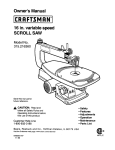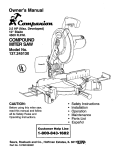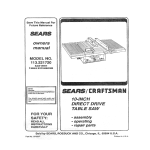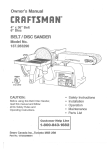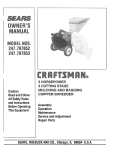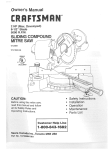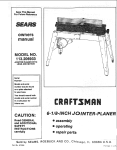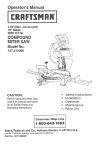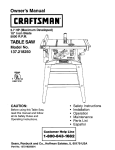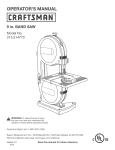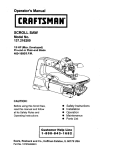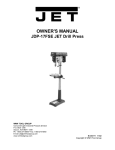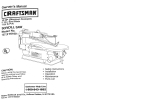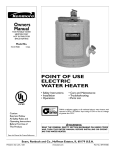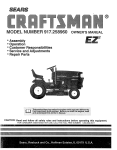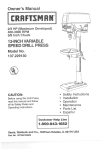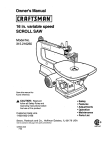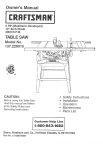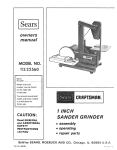Download Craftsman 137.212920 Operating instructions
Transcript
SLUDENGCOMPOUND M_TER SAW E82443 C@US 37J2 LISED CAUTION: o o o o o o Before using this Sliding Miter Saw, read this manual and follow all its Safety Rules and Operating Instructions. Customer Help Safety Instructions Installation Operation Maintenance Parts List EspaSol Line 1 o800o843o1682 Sears, Roebuck and Co., Hoffman Part No. 137212920002 Estates, IL 60179 USA SECTION PAGE Warranty .............................. Product Specifications ................... Safety instructions ...................... Accessories and Attachments ............. Carton Contents ........................ Know Your Sliding Miter Saw .............. Glossary of Terms ..... ..................................... Assembly and Adjustments ................................... Operation ............................................... Maintenance .................... i... : ..................... Troubleshooting guide ....................................... Parts ..................................................... EspaSol ................................................................ BEFORE USING THE SUD_NG _TER I_l==l_l==l======_lu_==_=.J==om=j MOTOR Power source ......... Horsepower .......... Speed .............. Brake ......... _ ..... Double insulated ...... 120 VAC, 60 HZ, 15 AMPS 3 HP (Max. Developed) 4300 R.RM. Electric Yes GENERAL SAFETY mNSTRUCT_ONS Safety is a combination of common sense, staying alert and knowing how to use your sliding miter saw. ........... ........... 11 12 • ; ......... ........... ........... 20 28 29 ........... 30 39 i , TABLE DIAMETER 20-5/8" KEEP GUARDS _NPLACE and in working order. 3. REMOVE ADJUSTING KEYS AND WRENCHES. Form the habit of checking to see that keys and adjusting wrenches are removed from the tool before turning ON. ........... AUXILIARY FENCE EXTENSION Yes ... Yes MITRE DETENT STOPS ... 0, 15, 22.5, 31.6, 45" R & L BEVEL POSITIVE STOPS.. 0, 33.9 & 45" L CARRIAGE SYSTEM 3 Rail, ball bearing slide BLADE SIZE ...... ..... ...... ................. To avoid electrical hazards, fire hazards, or damage to the tool, use proper circuit protection. Your sliding mitre saw is wired at the factory for 120V operation. Connect to a 120',/, 15 AMP time delay fuse or circuit breaker. To avoid shock or fire, replace power cord immediately if it is worn, cut or damaged in any way. 12" Crystalline silica from bricks, cement and other masonry Arsenic and chromium from chemically-treated lumber activities or other products Your risk from these exposures varies, depending on how often you do this type of work. To reduce your exposure to these chemicals:work in a well ventilated area. and work with approved safety equipment, such as those dust masks that are specially designed to filter out microscopic particles 8. 9. .I 15. DBCONNECT TOOLS before servicing, and when changing accessories, such as blades, bits, cutters, and the like. KEEP WORK AREA CLEAN. Cluttered areas and benches invite accidents. 16. REDUCE THE RISK OF UNiNTENTiONAL STARTING. Make sure the switch is in OFF position before plugging in. 17. USE RECOMMENDED ACCESSORIES. Consult the owner's manual for the recommended accessories. The use of improper accessories may cause risk of injury to persons. MAKE WORKSHOP KID PROOF wilh padlocks, master switches, or by removing starter keys. 18. NEVER STAND ON TOOL. Serious injury could occur if the tool is tipped or if the cutting tool is unintentionally contacted. DON'T FORCE THE TOOL. It will do the job better and safer at the rate for which it was designed. 19. CHECK FOR DAMAGED PARTS. Before further use of the tool, a guard or other part that is damaged should be carefully checked to determine that it will operate properly and perform its intended function. Check for alignment of moving parts, binding of moving parts, breakage of parts, mounting, and any other conditions that may affect its operation. A guard or other part that is damaged should be properly repaired or replaced. USE THE RIGHTTOOL Don't force tool or the attachment to do a job for which it was not designed. 10. USE PROPER EXTENSION CORD. Make sure your extension cord is in good condition. When using an extension cord, be sure to use one heavy enough to carry the current your product will draw. An undersized cord will cause a drop in line voltage resulting in loss of power and overheating. The table on page 7 shows the correct size to use depending on cord length and nameplate ampere rating. If in doubt, use the next heavier gauge. The smaller the gauge number, the heavier the cord. 20. NEVER LEAVE TOOL RUNNING UNATTENDED. TURN THE POWER OFF. Don't leave the tool until it comes to a complete stop. 21. DON'T OVERREACH. balance at all times. 11. WEAR PROPER APPAREL. DO NOT wear loose clothing, gloves, neckties, rings, bracelets, or other jewelry which may get caught in moving parts. Nonslip footwear is recommended. Wear protective hair covering to contain long hair. SAVE THESE !i! i ! ::: :::::i:i:ii::i:! ¸¸::!: i¸iii:! i!: ii!i Keep proper footing and 22. MAINTAIN TOOLS WITH CARE. Keep tools sharp and clean for best and safest performance. Follow instructions for lubricating and changing accessories. 23. DIRECTION OF FEED. Feed work into a blade or cutter against the direction of rotation of the blade or culter only. NSTRUCT ONS 3 2 ALWAYS WEAR EYE PROTECTION. Any miter saw can throw foreign objects into the eyes which could cause permanent eye damage. ALWAYS wear Safety Goggles (not glasses) that comply with ANSI safety standard Z87.1. Everyday eyeglasses have only impact-resistant lenses. ]hey ARE NOT safety glasses. Safety Goggles are available at Sears. NOTE: Glasses or goggles not in compliance with ANSI 2:87.1 could seriously hurt you when they break. 14. SECURE WORK. Use clamps or a vise to hold work when practical. It's safer than using your hand and it frees both hands to operate tool. KEEP CHILDREN AWAY. All visitors should be kept at a safe distance from the work area. Lb. , Some dust created by power sanding, sawing, grinding, drilling, and other construction contains chemicals known [to the State of Califcrnia] to cause cancer, birth defects reproductive harm Some examples of these chemicals are: e Lead from lead-based paints ® 61.6 W_ARYOUR 13. WEAR A FACE MASK OR DUST MASK. Sawing operation produces dust. DON'T USE IN A DANGEROUS ENVIRONMENT. Don't use power tools in damp or wet locations, or expose them to rain. Keep work area welt lighted. 5. DUST COLLECTION READ and become familiar with this entire instruction manual. LEARN the tool's applications, limitations, and possible hazards. 2. . 5/8" ............. To avoid mistakes that could cause serious injury, do not plug the miter saw in until you have read and understood the following: 6, 4" x 12-5/8" 4" x 8-3/4" 2-1/2" x 12-5/8" 2-1/2" x 8-3/4" SAW 2 ARBOR SIZE .................. NET WEIGHT CUTTING CAPACITY 0" Mitre - 0' Bevel ..... 45" Mitre - 0 r Bevel .... 0 r Mitre - 45" Bevel .... 45' Mitre - 45" Bevel ... 12. 14. KEEP HANDS out of the path of the saw blade. If the workpiece you are cutting would cause your hand to be within 6-1/2 inches of the saw blade, the W0rkpiece should be clamped in place before making the cut. 24. DO NOT operate the tool if you are under the influence of any drugs, alcohol or medication that could affect your ability to use the tool properly. 25. WARNnNG: Dust generated from certain materials can be injurious to your health. Always operate miter saw in well ventilated areas and provide for proper dust removal. 15. MAKE SURE the blade and collars are clean and properly arranged. After installing a new blade, make sure the blade clears the table slot at the 0o and 45 ° bevel positions. Lower the blade into the table slot and check for any contact with the base or turn table structure. If the blade contacts the table, see the TROUBLESHOOTING GUnDE for "depth stop adjustment" or contact the Sears Service Center. Broken saw parts could injure you or others. SPEC HC SAFETY NSTRUCT ONS FOR SUDRNG VHTER SAWS 1. 2. 3. 4. 5. 6. 7. 8. 9. READ AND UNDERSTAND all safety instructions and operating procedures throughout the manual. 16. ALWAYS check the blade for cracks or damage before operation. Replace a cracked or damaged blade immediately. DO NOT operate the miter saw until it is completely assembled and installed according to the instructions. SHOULD any part of your miter saw be missing, damaged, or fail in any way, or any electrical component fail to perbrm properly, shut off tile switch and remove the plug from the power supply outleL Replace missing, damaged, or failed parts before resuming operation. 17. USE blades recommended 19. TO KEEP the pivot nut from working its way off as you use the saw, at least one thread of the pivot bolt must always stick out past the nut. Always keep the nut at least that tight. IFYOU ARE NOT thoroughly familiar with the operation of miter saws, obtain advice from your supervisor, instructor, or other qualified person. 20. FAILURE TO'RGHTEN the jam nut could let the depth stop slip and let the blade strike the saw table. Broken saw parts could injure you or others. NEVER CARRY the tool by the cord or the cutting head handle. Damage to the insulation could cause electric shock. Damage to the wire connections could cause a fire. 21. CLEAR EVERYTHING except the workpiece and related support devices off the table before turning the miter saw on. SERIOUS _NJURY could occur if the tool tips over or you accidentally hit the cutting tool. Do not store anything above or near the tool. 22. MAKE SURE all clamps and locks are tight and there is no excessive play in any part. 23. ALWAYS MAKE SURE all handles are tight before cutting, even if the table is positioned in one of the positive stops. AVOID nNJURY from unexpected saw movement. Place the saw on a firm level surface where the saw does not rock, and bolt or clamp the saw to its support. 24. MAKE SURE there are no nails or foreign objects in •the part of the workpiece to be cut. BEFORE MOWNG the saw, lock the miter, bevel, and cutting head positions. 25. MAKE SURE the blade is not contacting the workpiece before the switch is turned on. CHOOSE the right 12" diameter blade for the material and the type of cutting you plan to do. Never use blades larger or smaller in diameter than recommended. 10. USE ONLY CROSSCUTTING SAW BLADES. Do not use blades with deep gullets as they can deflect to the side and contact the guard. 11. USE only blade collars specified for your saw. The recessed sides must Pace the blade ...... 12. USING THE HEX BLADE WRENCH supplied, make sure the arbor screw is firmly tightened. 13. NEVER USE the saw without the cover plate securely in place. It keeps the arbor screw from falling out if it accidentally loosens, and orevents the spinning blade from cornJng off the machine. at 4300 RPM or greater. 18. ALWAYS keep the blade guards in place. 26. ALWAYS hold the work firmly against the fence and table. DO NOT perform any operation freehand. . 27. DO NOTTRYTO CUT SHORT PIECES, You cannot piopefiy _up#6!t ih6w0ikpiece and keep yoUr hoiGd0wn hand the required distance from the blade. 28. ALWAYST_GHTENTHE CLAMP so that the workpiece is secured between the clamp and fence or base. No visible gap should be present between saw and wood. 29. NEVER cut metals or masonry. Because of the sliding action of the saw, this machine is not designed for cutting metals. Use this miter saw to cut only wood and woodlike products. Other materials may shatter, bind on the blade, start fires or create othe- dangers. 30. NEVER reach around the saw blade. SAVE THESE WNSTRUCT ONS 3"1• NEVER PULL THE SAW toward you during a cut. The blade can suddenly climb up on Iop of the workpiece and force itself toward you. SMOOTH, solid movement of sliding assembly. OTHER conditions that may affect the way the miter saw works. If any part of the miter is missing, bent, or broken in any way, or any electrical parts don't work, turn the saw off and unplug it. REPLACE damaged, missing, or failed parts before using the saw again. 32. ALLOW the motor to come up to full speed before starting cut. 33. KEEP the motor air slots clean and free of chips. 34. NEVER apply lubricants to the blade when it is running. 4+3, 35. MAKE SURE the blade has come to a complete stop before removing or securing the workpiece, changing the workpiece angle, or changing the angle of the blade. 44. REMOVE adjusting keys and wrenches from the tool before turning it on. 36. NEVER use the miter saw in an area with flammable liquids or gases. 45. TO AVOID INJURY FROM JAMS, SMPS, OR THROWN PECES: ° USE ONLY RECOMMENDED ACCESSORIES. Consult this Owner's Manual for recommended accessories. Follow the instructions that come with the accessories. The use of improper accessories may cause risk of injury to persons. o MAKE SURE the blade is sharp, undamaged, properly aligned and free of vibration. With the saw unplugged, push the cutting head all the way down. Hand spin the blade and check for clearance. Tilt the cutting head to a 45 degree bevel and repeat the check. If the blade hits anything, see the TROUBLESHOOTING GUIDE for "depth stop adjustment", or contact your Sears Service Center. 37. NEVER use solvents to clean plastic parts. Solvents could possibly dissolve or otherwise damage the material. 38. ALWAYS PERFORM DRY RUNS+ Make sure the saw is unplugged. Completely set up your saw. Pull the blade and cutting head through the full range of motion to check for interference. When using a clamp make sure that your blade, saw guard or motor does not interfere with the clamp. Correct any interference before use. 39. PLAN HOW YOU WILL MAKE THE CUT: ° MAKE SURE the blade is net spinning. , RAISE the blade. , SUDE the saw out above the front edge of the workpiece before starting the saw. PUSH the saw blade down on top of the wood and back toward the rear of the saw to make the cut. BEFORE KEEP GUARDS UNPLACE, in working order, and in proper adjustment. Maintain tools with care. Keep the miter saw clean for best and safest performance. Follow instructions for lubricating. DON'T put lubricants on the blade while it's spinning, 46. PLAN HOW you will hold the workpiece from start to finish: + EACH USE 40. JNSPEOTYOUR ° MITER SAW. ° 41. D+SCONNECTTHE M_TER SAW. To avoid injury from accidental starting, unplug the saw before changing the setup, changing the blade, or adjusting anything. Compare the direction of the rotation arrow on the guard to the direction arrow on the blade. The blade teeth should always point downward at the front of the saw. Tighten the arbor screw. Tighten the cover plate screw. + 42. CHECK FOR DAMAGED PARTS° Check for: ° PROPER alignment of moving parts + DAMAGED electric cords , BINDING of moving parts ° BROKEN parts + STABLE mounting + FUNCTION of arm return spring and lower guard: Push the arm all the way down, then let it rise up until it stops by itself. Check the lower guard to see if it closed fully. If it did not, follow the instructions in the TROUBLESHOOTONG GUDDE. SAVE THESE ° ° , ° AVOID awkward operations and hand positions where a sudden slip could cause fingers or hand to move into the blade. DON'T OVERREACH. Keep good footing and balance. KEEP your face and body to one side of the saw blade, out of line with a possible throwback. NEVER CUT FREEHAND: + BRACE your workpiece solidly against the fence and table top so it will not rock or twist during the cut. MAKE SURE there is no debris between the workpiece and its supports. - MAKE SURE no gaps between the workpiece, fence and table wilt let the workpiece shift after it is cut in two. CUT only one workpiece at a time. KEEP the cut off piece free to move sideways after it is cut off. Otherwise it could get wedged against the blade and be thrown violently• CLEAR everything except the workpiece and related support devices off the worktable before turning the miter saw on. SECURE WORK. Use clamps or a vise to help hold the work when it is practical. NSTRUCT ONS 5 47. USEEXTRACAUTION withlarge,verysmallor awkwardworkpieces: USEextrasupports(tables,sawhorses,blocks, etc.)foranyworkpieces largeenoughtotip whennothelddownto thetabletop. o NEVERuseanotherpersonas a substitute fora tableextension, or asadditionalsupportfora workpiece thatis longeror widerthanthebasic mitersawtable,or to helpfeed,supportor pull theworkpiece. o DONOTUSEthissawto cutpiecestoosmallto letyoueasilyholdthe work. WHENCUTTING irregularlyshapedworkpieces, planyourworkso itwill notslipandpinchthe bladeandbetornfromyourhands.A pieceof molding,forexample,mustlieflator beheldby a fixtureor jigthatwillnot letit twist,rockor slip whilebeingcut. o PROPERLY SUPPORT roundmaterialsuchas dowelrods,ortubing.Theyhavea tendencyto rollwhilebeingcut,causingthebladeto"bite". Toavoidthis,alwaysusea fixturedesignedto properlyholdyourworkpiece. 54. BEFORE LEAVING THE SAW: NEVER LEAVE the tool running unattended. Turn the power OFR Wait for all moving parts to stop. MAKE WORKSHOP child proof. Lock the shop. Disconnect master switches. Store the tool away from children and others not qualified to use the tool. 55. NEVER unplug the saw with the switch in the ON position. 56. DISCONNECT the saw from the power source and clean the machine before leaving it. MAKE SURE the work area is clean before leaving the machine. ELECTRICAL REQUIREMENTS POWER SUPPLY SPECIFICATIONS 49. KEEP CHILDREN AWAY. Keep all visitors a safe distance from the miter saw. Make sure bystanders are clear of the miter saw and workpiece. 50. LET THE BLADE reach full speed before cutting. This will help avoid thrown workpieces. 51. DON'T FORCE THE TOOL. It will do the job better and safer at its designed rate. Feed the saw into the workpiece only fast enough to let the blade cut without bogging down or binding. 52. BEFORE FREEING JAMMED MATERIAL: o TURN miter saw OFF by releasing trigger switch. o WAiT for all moving parts to stop. o UNPLUG the miter saw. To avoid electrical hazards, fire hazards, or damage to the tool, use proper circuit protection. Your saw is wired at the factory for 120V operation. Connect to a 120V, 15 Amp circuit and use a 15 Amp time delay fuse or circuit breaker. To avoid shock or fire, if power cord is worn or cut, or damaged in any way, have it replaced immediately. Replacement parts - When servicing use only identical replacement parts. Polarized plugs - This saw has a plug that looks like the one shown below: SAVE THESE INSTRUCTIONS , . 7 7 ; Y 7 r 7 t CORDS PROTECTION Be sure your extension cord is properly wired and in good condition. Always replace a damaged extension cord or have it repaired by a qualified person before using it. Protect your extension cords from sharp objects, excessive heat and damp or wet areas. Use a separate electrical circuit for your tools. This circuit must not be less than #12 wire and should be protected with a 15 Amp time lag fuse. Before connecting the motor to the power line, make sure the switch is in the OFF position and the electric current is rated the same as the current IF the motor won't start, release the trigger switch immediately. UNPLUG THE TOOL. Check the saw blade to make sure it turns freely. If the blade is free, try to start the motor again. If the motor still does not start, refer to the TROUBLESHOOTING GUIDE. stamped on the motor nameplate. Running at a lower voltage will damage the motor. tF the motor suddenly stalls wMe cutting wood, release the trigger switch, unplug the tool, and free the blade from the wood. The saw may now be restarted and the cut finished. (when using 120 volts only) Ampere FUSES may "blow" or circuit breakers rnay trip frequently if: a. MOTOR is overloaded. Overloading can occur if you feed too rapidly or make too many start / stops in a short time. b. LINE VOLTAGE is rnore than 10% above or below the nameplate voltage. For heavy loads, however, the voltage at motor terminals must equal the voltage specified on the nameplate. c. IMPROPER or dull saw blades are used. Rating Totallength ofcordinfeet more than not nlole Ihal] 25' 50' 100' 150' 0 6 18 16 16 14 6 t0 18 16 14 12 10 12 16 16 14 12 12 16 14 12 Notrecommended CAUTION: In all cases, make certain the receptacle in question is properly grounded. If you are not sure have a certified electrician check the receptacle. SAVE THESE INSTRUCTIONS 7 77 FOR EXTENSION USE PROPER EXTENSION CORD. Make sure your extension cord is in good condition. When using an extension cord, be sure to use one heaW enough to carry the current your product will draw. An undersized cord will cause a drop in line voltage, resulting in loss of power and cause overheating. The table below shows the correct size to use depending on cord length and nameplate ampere rating. If in doubt, use the next heavier gauge. The smaller the gauge number, the heavier the cord. CONNECT this tool to a 120V, 15 Amp branch circuit with a 15 Amp time delay fuse or circuit breaker. Using the wrong size fuse can damage the motor. , MOST motor troubles may be traced to loose or incorrect connections, overload, low voltage (such as small size wire in the supply circuit) or to overly long supply circuit wire. Always check the connections, the load and the supply circuit if the motor doesn't work well. Check wire sizes and length with the Extension Cord Chart below. GUIDELINES IMPORTANT: To avoid motor damage, this motor should be blown out or vacuumed frequently to keep sawdust from interfering with normal motor ventilation. _] The miter saw is double insulated to provide a double thickness of insulation between you and the tool's electrical system. All exposed metal parts are isolated from the internal metal motor components with protecting insulation. 53. AFTER FINISHING A CUT: o KEEP holding the cutting head down. o RELEASE the switch, keeping the cutting head down, and wait for all moving parts to stop before moving your hands. o IF BLADE doesn't stop within 6 seconds, unplug the saw and follow the instructions in the TROUBLESHOOTING GUIDE for fixing the blade brake before using the saw again. To avoid electrocution: o Use only identical replacement parts when servicing a tool with double insulation. Servicing should be performed by a qualified technician. o Do not use power tools in wet or damp areas or expose them to rain. o This tool is intended for indoor use only. o Double insulation does not take the place of normal safety precautions when operating this toot. MOTOR SAFETY The AC motor used in this saw is a universal, nonreversible type. See "MOTOR" in the PRODUCT SPECIFiCATiONS section on page 2. DOUBLE INSULATED , AND MOTOR WHEN THE SAW IS RUNNING 48. BEFORE STARTING your cut, watch the miter saw while it runs. If it makes an unfamiliar noise or vibrates a lot, stop immediately. Turn the saw OFF. Unplug the saw. Do not restart until finding and correcting the problem. To reduce the risk of electrical shock, this saw has a polarized plug (one blade is wider than the other). This plug will fit in a polarized outlet only one way. If the plug does not fit fully in the outlet, reverse the plug. tf it still does not fit, contact a qualified electrician to install the proper outlet. Do not change the plug in any way. UNPACKING PROHiBiTED ACCESSORIES To avoid injury: ° Use only accessories recommended for this sliding miter saw. Follow instructions that accompany accessories. Use of improper accessories may cause hazards. o The use of any cutting tool except 12 inch saw blades which meet the requirements under recommended accessories is prohibited. Do not use accessories such as shaper cutters or dado sets. Ferrous metal cutting and the use of abrasive wheels is prohibited. • Do not attempt to modify this tool or create accessories not recommended for use with this tool. Any such alteration or modification is misuse and could result in a hazardous condition leading to possible serious injury. Read warnings and conditions on your CARBIDETIPPED SAW BLADE. Do not operate the saw without the proper saw blade guard in place. Carbide is a very hard but brittle material. Care should be taken while mounting, using, and storing carbide blades to prevent accidental damage. Slight shocks, such as striking the tip while handling, can seriously damage the blade. Foreign objects in the workpiece, such as wire or nails, can also cause tips to crack or break off. Before using, always visually examine the blade and tips for bent blade, cracks, breakage, missing or loose tips, or other damage. Do not use if damage is suspected. Failure to heed safety instructions and warnings can result in serious bodily injury. YOUR COMPOUND SLIDING MBTER SAW UNPACKING AND CHECKING CONTENTS To avoid injury: • Do not plug the power cord into a power source receptacle during unpacking and assembly. This cord must remain unplugged whenever you are working on the saw. Get help whenever you have to lift the saw. This saw is heavy. If any part is missing or damaged, do not plug the sliding miter saw in until the missing or damaged part is replaced, and assembly is complete. To avoid electric shock, use only identical replacement parts when servicing double insulated tools. Carefully unpack the sliding miter saw and all its parts, and compare against the illustration on page 9. 1. Before removing the saw from the shipping carton, tighten the carriage lock knob to guard against sudden movement. 2. DO NOT LIFT the sliding miter saw by the cutting head handle. Damage to the insulation or wire connections could cause fire. Remove the saw from the carton by lifting with the hand-holds at the base of the saw body, or use the carry handle. 3. Place the saw on a secure, stationary work surface and look the saw over carefully. TABLE ITEM A. B. C. D, E. R OF LOOSE PARTS DESCRIPTION Sliding miter saw Dust collection chute Dust collection elbow Auxiliary fence Dust bag Blade wrench QUANTITY 1 1 1 1 1 1 B C D 0 o E CRAFTSMAN SAW TERMS Dust bag COMPOUND MUTER ARBOR LOCK - Allows the user to keep the blade from rotating while tightening or loosening the arbor screw during blade replacement or removal. Depth stop bolt ON/OFF trigger switch SLiDiNG Lock pin BASE - Supports the table, holds accessories and allows for workbench mounting. Blade storage Power cord storage Lock-off switch }arriage lock handle Depth adjustment 45 ° Bevel stop 90 ° Bevel stop Bevel lock handle Bevel scale handle BEVEL ADJUSTMENT STOPS = Bolts that are adjusted to stop the saw blade at 0° and 45 ° bevel. BEVEL POS_TaVE STOP LOCK - Locks the miter saw at the 33.9 ° bevel angle positive stop. BEVEL LOCK HANDLE - Locks the miter saw at a desired bevel angle. BEVEL SCALE - Measures the bevel angle of the saw blade. BLADE WRENCH - Fits the arbor screw for removing and replacing the blade. CARRaAGE LOCK HANDLE - Prevents the saw's sliding motion by locking the carriage in place. COVER PLATE - Holds the lower guard and is attached to the upper guard. It prevents the arbor screw from backing out. Arbor lock Upper bladeguard Brush covers Miter lock handle Motor Slide carry handle cover plate Slide bar cover Lower Dust collection elbow blade guard CUTTING HEAD ASSEMBLY - Consists of pivot arm, blade, upper and lower blade guards, motor, arbor and pin locks, and switch on handle. Components work together to perform cutting operation. DEPTH ADJUSTMENTdepth. Allows setting of desired cutting DEPTH STOP BOLT - Limits the saw blade travel to approximately 1/4" below the table. Miter scale -- Exhaust port Dust exhaust collection chute Auxiliary fence Turntable Hand-holds Blade wrench Mounting Base holes lO Fence MOUNTING HOLES - Provides a means of mounting the sliding miter saw to a stable work surface. ON / OFFTRIGGER SWITCH - Starts the saw when squeezed. As a safety feature, the lock-oft button must be pushed to activate the trigger and turn the saw ON. Release timetrigger to turn the saw OFR SLIDE BAR COVER - Covers and protects the 3 slide carriage rails. SWITCH HANDLE - Contains the trigger switch with a lock-off button. The blade is lowered by pushing down on the handle, and returns to the upright position when the handle is released. TURNTABLE - Sits in the base, supports the workpiece, and allows rotation for miter cutting. UPPER BLADE GUARD - Protects the user from the saw blade teeth. WARNING LABELS - Informs the user of dangers and necessary precautions in the use of this saw. Read carefully before using. WOODWORKUNG TERMS ARBOR - The shaft on which the blade is mounted. BEVEL CUT - An angle cut made through the face of a workpiece. COMPOUND CUT - A simultaneous bevel and miter cut. CROSSCUT - A cut made across the width of the workpiece. DUST BAG - Provides a means of collecting sawdust. DUST COLLECTION ELBOW - Provides a means of attaching a vacuum or dust collection bag. FREEHAND - Performing a cut without using a fence (guide), hold-down or other proper device to prevent the workpiece from twisting during the cutting operation. DUST COLLECTION CHUTE - Fits into the exhaust port for efficient sawdust exhaust. HEEL - Misalignment of the blade. EXHAUST PORT - Exhausts debris away from the operator. Bevel positive stop lock MITER SCALE - Measures the miter angle of the saw blade. Positive stop index points have been provided at 0, 15, 22.5, 31.6, and 45 ° right and left. FENCE - Helps to keep the workpiece from moving when sawing. HAND-HOLD - Provides a means of safely carrying the saw. LOCK-OFF SW_TCH - Activates the ON / OFF switch when pushed. This prevents the trigger switch from being accidentally turned ON. GUM - A sticky sap based residue from wood products. KERF - The amount of material removed by a blade in a through cut, or the slot produced by the blade in a partial cut. M_TER CUT - An angle cut made across the width of a workpiece. RESIN - A sticky sap that has hardened. REVOLUTIONS PER MINUTE (RPM) - The number of turns completed by a spinning object in one minute. LOCK PIN - Locks the miter saw in the lowered position for compact storage. Use this only for carrying and storage applications. SAW BLADE PATH - The area of the workpiece or table top directly in line with the travel of the blade or the part of the workpiece which will be cut. LOWER BLADE GUARD - Protects the user's hands from the blade in the raised position. It retracts as the blade is lowered to avoid binding on the workpiece. SET - The distance between two tips of the saw blade teeth, bent outward in opposite directions to each other. MATER LOCK HANDLE - Rotates the saw to a right or left cutting position and locks the miter saw table at the desired miter angle. WORKP_ECE - The item being cut. The surfaces of a workpiece are commonly referred to as faces, ends, edges. ASSEIVlBLING THE MITER SAW THE DUST COLLECTION ASSEMBLY INSTRUCTIONS LOCKING THE CUTTING HEAD (FIG. B) When transporting or storing the miter saw, the cutting head should always be locked in the down position: 1. Push the cutting head (2) down to its lowest position. 2. Push the lock pin (3) into the locking hole (4). After transporting, raise the cutting head before use: 1. Push down slightly on the cutting head (2). 2. Pull out the lock pin knob (3). 3. Allow the cutting head to raise to the up position. TOOLS NEEDED Adjustable wrench Hex blade wrench (supplied) Hex key Phillips screwdriver THE AUXILIARY FENCE (FIG. E) SYSTEM (FIG. C, D) Installing The Dust Collection Chute And Elbow (FIG. C) 1. Place the dust chule (1) into the exhaust port (2) below the cutting arm. 2. Install the larger end of the elbow (3) onto the exhaust port from the rear of the miter saw. Aim the elbow to the side or down. For your safety, never connect the plug to the power source outlet until all assembly and adjustment steps are completed, and you have read and understood the safety and operating instructions. The auxiliary fence (1) may be installed three different ways to provide the position appropriate to the job. See ADJUSTMENTS AND ALIGNMENTS Section. Install the auxiliary fence when needed by: 1. Aligning the table fence set pin (2) to the auxiliary fence (1). 2. Align the auxiliary fence insert tabs (3) to the table fence. 3. Press into position and tighten the fence lock knob (4). NOTE: The elbow can be used to attach either the dust bag or a vacuum hose to remove sawdust from the work area. Fig. C iMPORTANT: To avoid damage, never carry the miter saw by the switch handle, the cutting arm, or the miter table tlandle. ALWAYS use the hand holds in the base or the slide carriage carry handle. Combination square To avoid injury: o When moving tool from one location to another location, lock the sliding carriage, lock the cutting head, and lift saw only by the hand hold openings on both ends of the base, using both hands. o This saw is heavy, get help whenever you have to lift the saw or move the saw from one location to another. Never connect the plug to the power source receptacle until all assembly and adjustment steps are completed, and you have read and understood the safety and operating instructions. Fig. E To avoid injury and damage to the saw, transport or store the miter saw with the cutting head in the down position. NEVER use the lock pin to hold the cutting head in a down position for cutting operations. installing The Dust Bag (FIG. D) 1, To install the dust bag (4), squeeze the metal collar wings (5). 2. Place the dust bag neck opening around the dust chute elbow (3) or the motor area exhaust port (6), and release the metal collar wings. MOVING THE MITER SAW LOCKING THE SLIDING CARRIAGE (FIG. A) When transporting or storing the miter saw, the sliding carriage should always be locked in position. The carriage lock handle (1) is located on the side of the sliding carriage. Turn the handle clockwise to lock, counterclockwise to unlock. STORAGE (FIG. F, G) Wrench (FIG. F) For convenient storage and prevention of loss, there is a slot (1) in the rear of the cutting head handle (2) for storing the blade wrench (3) when not in use. Fig. D Fig. A 12 13 Power Cord (FIG, G) For convenience and to prevent damage to the power cord when the miter saw is not in use or is being transpor[ed, the sliding carriage cover Ilas two brackets (4) on the side for cord storage. Fig. H 1. 2. 3. 4. 5. 6. 7. 8. 9. Fig. G 4 Sliding miter saw Hex head bolt Rubber washer Flatwasher Workbench Flatwasher Lockwasher Hex nut Jamb nut REMOVING OR iNSTALLiNG TNE BLADE . Before moving the saw To avoid injury from unexpected saw movement: * Disconnect the power cord from the outlet, and lock the cutting head in the lower position using the lock pin. NOTE: The arbor lock can be damaged by improper use. If the arbor lock will not hold, lower the blade down on to a scrap of wood positioned against the fence. This will serve as an alternative locking method. 3 4 i---- I I I I [J 5 i I I To avoid injury: Only use blades recommended for this saw, with the proper diameter of 12 inches and designed for blade speeds not less than 4300 RPM o Make sure the switch is in the OFF position and the plug is not connected to the power source receptacle. 9. Removing The Blade 1. Unplug timesaw from the outlet. 2. Allow the miter saw cutting head to rise to the upright position. 3. Rotate lower blade guard (1) up until the slot (2) in the arbor cover plate is exposed. 4. Wedge a rod or dowel (3) into the slot to hold the blade guard up, exposing the arbor bolt (4). 5. Place the blade wrench (5) over the arbor bolt. Fig. K o o For portable use, place the saw on 3/4" thick plywood (5). Bolt the base (1) of the miter saw securely to the plywood using the mounting holes (10) on the base. Use C-clamps (11) to clamp this mounting board to a secure surface (12) at the worksite. (FIG. H1) 4 Fig. H1 Lock the slide carriage in place by tightening the carriage lock knob. To avoid back injury, lift by using the hand-hold access at the bottom of the base, or use the carry handle. Bend with your knees, not your back. Never carry the miter saw by the power cord or by the switch handle. CarrYing the tool by the power cord could cause damage to the insulation or the wire connections resulting in electric shock or fire. To avoid injury from flying debris, do not allow visitors to stand behind the saw. Mounting instructions 1. Place the saw on a firm, level workbench Or other work surface. The base of timesaw has four mounting holes. 2. For stationary use, place the saw in the desired location, directly on a workbench, where there is room for handling and properly supporting the workpieces. Bolt the base of timemiter saw (1) to the worksur[ace (5), using the fastening method as shown in Fig. Ho \ Fig. 4 IMPORTANT: Make sure the flats of the blade collar are engaged with the flats of the arbor shaft. J3 6. Locate the arbor lock (6) on the motor, below the miter saw switch handle. 7. Press the arbor lock, holding it in firmly while turning the blade wrench clockwise. The arbor lock will engage after the wrench is turned. Continue to hold the arbor lock in to keep it engaged while turning the wrench clockwise to loosen the arbor bolt. 8. 12 7 Installing The Blade 10. Install a 12" blade (8), making sure the rotation arrow on the blade matches the clockwise rotation arrow on the upper blade guard. 11. Install the outer blade collar (7) and the arbor bolt (4). (FIG.K) NOTE: The lock pin is for carrying and storage use only. It is NOT to be used for holding the saw while cutting. o Remove the arbor bolt (4), outer blade collar (7) and the blade (8). Do not remove the inner blade collar. NOTE: Pay attention to the pieces removed, noting their poskion and direction they face. Wipe the blade collars clean of any sawdust before installing the new blade. I NOTE: Mounting hardware not included with this Lool. Bolts, nuts, washers, screws, and clamps must be purchased separately. MOUNTING THE MITER SAW (HG. H, HI) (FIG, J,J, K) 12. Place the blade wrench on the arbor bolt. 13. Press the arbor lock (6), holding it in firmly while turning the blade wrench counterclockwise. When it engages, continue to press the arbor lock in while tightening the arbor bolt securely. 14. Remove dowel from the blade guard and allow the blade guard to lower. 15. Be sure the arbor lock is released so the blade turns freely. FRg. J 11 To avoid injury, make sure the collars are clean and properly arranged. After installing a new blade, make sure the blade clears the table slot at the 0 ° and 45 ° bevel oositions. Lower the blade into the table ana check for any contact with the metal base or the turntable. 15 REMOVING AND iNSTALLiNG TABLE INSERT (FIG. L) To avoid injury: and materials being thrown, always unplug the saw to avoid accidental starting. Remove small pieces of material from the table control arm cavity. The table insert may be removed for this purpose, but always reattach the table insert prior to performing a cutting operation. o Do not start the sliding con'}pound miter saw without checking for interference between the blade and table insert. Damage could result to the blade, table insert or turntable if blade strike occurs during the cutting operation. 1. 2. 3. 0° Adjustment (FIG. M) 1. Rotate the table to the 0 ° position and lock into place. Tighten the miter handle (1). 2. Loosen the bevel lock handle (2) and tilt the cutting arm completely to the right. Tigtlten the bevel lock handle. 3. Using a combination square (3), place the square rule on the turntable and the heel against the blade. Check that the blade is 90 ° to the table. 4. To adjust, loosen the Iocknut (4) and turn the bolt (5) in or out until the blade is set at 90" to the table. Tighten the Iocknut. 45 ° Beve_ Adjustment (F1G. O) 1, Loosen the bevel lock handle (2) and tilt the cutting arm completely to the left position. Tighten the bevel lock handle. 2. Using a combination square (3), check to see if the blade is at a 4.5" angle to the table. 3. To adjust, loosen the Iocknut (8) and turn the bolt (9) in or out until the blade is at 45 ° to the table. Tighten the Iocknut. . Readjust the bevel indicator (6) if necessary, using a screwdriver. Adjust the indicator so the pointer (7) aligns with the 45 ° line on the scale. Fig. O Fig. M 9 5-- Miter Sca_e _ndicator (F_G, P) 1. Move the control arm to the 0 ° positive stop, perpendicular to the saw base. 2. Loosen the screw (3) that holds Ihe indicator with a screwdriver. 3. To Square Blade to Fence (FIG. Q): 1. Turn the table to the 0 ° miter position, perpendicular to the saw base, and lock in position. 2. Using a hex key wrench, loosen the three fence locking hex socket bolts (1) one full turn, until the fence (2) is loose. 3. 4. To remove, loosen and remove the six screws (t) on the table insert (2) with a screwdriver and lift the insert. To install, reposition the table insert, install the six screws and tighten. Check for blade clearance by moving the carriage through the full motion of the blade in the slot. 5. Fig. L Lower the cutting head assembly (3) and lock it in the down position with the stop pin (4), as shown. Using a combination square (5), lay the heel of the square against the blade, and the rule against the fence (2) as shown. Check to see if the fence is 90 ° to the blade. If an adjustment is necessary, shift the fence forward or backward until the fence is square to the blade. Tighten the three fence locking bolts (1). CAUTION: If the saw has not been used recently, recheck blade squareness to the fence and readjust if needed. 2 M_TER ADJUSTMENTS 3 I ADJUSTMENTS Adjust the indicator (2) to the 0 ° mark and retighten screw. AND ALIGNMENTS Bevel Scale Indicator (FIG. N) 1. When the 0 ° bevel adjustment is complete, readjust the bevel indicator screw (6) using a screwdriver. 2. Adjust the indicator so the tip of the pointer (7) aligns with the 0 ° line (8) on the scale. Retighten the screw. To avoid injury: From unexpected starting or electrical shock, do not plug the saw in. The power cord MUST remain unplugged when you are working on the saw. (F_G. P) Fig. Q MiterTurntable (FIG. P) The sliding compound miter saw scale can be easily read showing miter angles from 0 to 45 ° to the left, and 0 to 45 ° to the right. The most common angle cut setting slots have positive stops, permitting fast adjustments to the desired position. Follow the process below for quickest and most accurate adjustments: 1. "Turnthe turntable miter lock handle (1) counterclockwise to unlock the table. 2. 3. Fig. N Move the turntable to align the indicator (2) to the desired degree measurement. Lock the table into position by turning the miter lock handle clockwise. F_go P To avoid injury disconnect the plug from the power source before performing any adjustments or repair. NOTE: Your compound saw was adjusted at the factory. However during shipment slight misalignment may have occurred. Check the following settings and adjust if necessary prior to using this miter saw. BEVEL STOP ADJUSTMENTS (FIG. M, N, O) NOTE: To ensure accurate cuts, alignment should be checked and adjustments made prior to use. i ¸ / ti Ji!ii / ! l J L> //¸¸ /! ill! i 17 iiiill i fill / i! // ! / /?./ //ii/ !/! ! i:!i_;ii!i!;ii!iiii!!i CUTTING DEPTH ADJUSTMENT (FIG, R) Setting Cutting Depth (FIG. R) The depth of cut can be preset for even arid repetitive shallow cuts. 1. Adjust the cutting head down until the teeth (1) of the blade are at the desired depth of cut. 2. Turn the stop nut (2), moving it toward the end of the depth adjustment bolt (3). 3. Tighten or loosen the other stop nut (4) against the depth stop block (5), moving the adjustment bolt in or out until the blade is stopped at the desired position when it is lowered. 4. Retighten both stop nuts against the depth stop block when the desired blade depth is achieved. 5. Recheck the blade depth by moving the cutting head front to back through the full motion of a typical cut along the control arm. Maximum Cutting Depth (FIG. R) The maximum depth travel of the cutting head was set at the factory. Check to see that the cutting head does not extend more than 1/4" below the table insert, and does not touch the control arm throat. If the maximum depth needs readjusting: 1. Readjust the depth adjustment bolt and stop nuts (2, 3, 4) to allow full travel of the cutting head. 2. Move the cutting head down until the blade extends just 1/4" below the table insert. 3. Turn the stop nut (6) to loosen. 4. Tighten or loosen the depth stop bolt (7), moving it in or out, until the blade is stopped at 1/4" below the insert. 5. 6. Retighten the stop nut (6) against tile stop block (8) to lock the depth stop bolt in place. Recheck the blade depth by moving the cutting head front to back through the full motion of a cut along the control arm. if the blade touches the inside of the control arm, readjust the setting. AUXILIARY FENCE POSITIONS (FIG. S, T, U) MITER CUTS (FIG. S) 1. When making a miter cut operation, position the auxiliary fence (1) as shown, matching the angled side (2) to the permanent table fence angled side (3). 2. Align the table fence set pin (4) to the hole (5) on the auxiliary fence. Press the pin into the auxiliary fence and the square insert blocks (6) into the table fence. 3. Tighten the lock knob (7). BEVEL AND COMPOUND CUTS 5 Other Bevel and Compound When performing bevel or compound cuts, the auxiliary fence position MUST be changed to avoid injury and to prevent interference with the blade, blade guard, and auxiliary fence. For bevel the crown MUST be to prevent Crown Molding 1. Cuts (FIG, T) NOTE: Crown molding cuts are made at the positive stop positions of 33.9 ° bevel, and 31.6 ° miter. Bevel and compound cuts of crown molding angles or less can be made with the auxiliary fence as shown: 1. Place the narrow edge (8) of the auxiliary fence (1) toward the blade, and the angled edge (2) toward the outside of the table, away from the cutting head. 2. Align the table fence set pin .(4) to the hole (5) on the auxiliary fence. Press the pin into the a:uxiliary fence and the insert blocks (6) into the table fence. 3. Tighten the lock knob (7). Fig. T 2 7 (FIG. T, U) 7 2. 3. Cuts (FIG. U) and compound cuts using a greater angle than molding position, the auxiliary fence position changed, and the dust collection chute removed, injury or damage. Position the auxiliary fence as shown, placing the narrow edge (8) toward the blade and the angled edge (2) toward the outside of the table. Align and insert the table fence set pin (4) into the hole (9) of the auxiliary fence. Press the pin into the auxiliary fence and the insert block (6) into the table fence. Tighten the lock knob (7). Fig. U To avoid injury: o o Always wear safety glasses and proper hearing protection such as ear plugs or other ear protection devices when performing cutting operations. Cut materials calmbe thrown and extensive exposure to noise can cause hearing problems. Don't allow familiarity, gained from frequent use of your miter saw, to result in a careless mistake. A careless fraction of a second is enough to cause a severe injury• Before cutting, if the saw makes an unfamiliar noise or vibrates, stop immediately. TL_rnthe saw OFF. Unplug the saw. To avoid injury, do not restart until finding and correcting the problem. Your saw has a blade brake. The brake is not a safety device. Never rely on it to replace the proper use of the guard on your saw. To prevent injury, if the blade does not stop within 6 seconds, unplug the saw and follow the instructions in the TROUBLESHOOTING GUIDE for adjusting the brake before continued use. BODY AND HAND POSITIONS (F_GoW) Proper positioning of your body and hands when operating the sliding miter saw will make cutting easier and safer. Use a hold down clamp assembly (sold separately) whenever possible. Never place Ilands near' the cutting area. Place your hand at least 6 1/2" away from the path of the blade. Hold the workpiece firmly against the fence to prevent movement toward the blade. Keep your hands in position until the trigger has been released and the blade has completely stopped• Stand in a position so the body is to the left side of the blade but never stand directly behind the blade when performing a cutting operation. Before making a cut, make a "dry run" with the power off so you can see the path of the blade. Fig. W BEFORE LEAVING THE SAW Never leave the tool running unattended. Turn the power OFF. Wait for all moving parts to stop and unplug the power cord from the outlet. Make the workshop child-proof. Lock the shop. Disconnect master switches. Store the tool away from children and other unqualified users. BASIC SAW OPERATIONS SLIDING CARRIAGE SYSTEM (FIG. X) 1. Loosen the slide carriage lock handle (1) clockwise, located on the side of the slide bar cover (2). 2. For a chop cutting operation on narrow workpieces, slide the cutting head assembly to the desired position and tighten the carriage lock handle counterclockwise. 3. To cut wide boards up to 12-1/8", the carriage lock handle should be loosened to permit the cutting head to slide freely. 1. 2. To make a miter cut, move the cutting head to the desired position by turning the miter lock handle (1) counterclockwise. This unlocks the miter lock and table. Rotate the turntable (2) to the desired miter angle on the scale (3), right or left. When the table is in the desired position, tighten the miter lock handle (1). The table is now locked at this position. NOTE: If using the auxiliary fence, position the fence as shown on page 18, matching the angled side of the auxiliary fence to the angled side of the permanent table fence. Fig. Y Fig. X 1 2 TO TURN SAW ON (FgG. V) To reduce the likelihood of accidental starting, a thumb activated lock-OFF switch is located on top of tile switch handle. The lock-OFF switch must be pushed forward before the trigger switch (2) canbe activated and the miter saw started. I NOTE: Make the switch child-proof. Insert a padlock, or a chain with a padlock, through the holes (3) in the trigger switch, and lock it. This will prevent children and other unauthorized users from turning the machine on. 2 Fig. V 6 1/2" "" ' Keep children away. Keep all visitors a safe distance from the miter saw. Make sure bystanders are clear of the miter saw and workplace. 3 2 Don't force the tool It will do timejob better and safer at its designed rate. Feed the saw into the workpiece slowly with a firm downward motion. Before freeing jammed material: a. Turn switch OFE b. Unplug the miter saw. c. Wait for all moving parts to stop. After finishing a cut: a. Keep holding the cutting head down. b. Release the switch, and wait for all moving parts to stop before moving your hands. c. If the blade doesn't stop within 6 seconds, unplug the saw and follow the instructions in the TROUBLESHOOTING GUIDE for adjusting the blade brake before using the saw again. Move feet with miter angle To avoid injury from materials being thrown, always unplug the saw to avoid accidental starting, and remove small pieces of material from the control arm cavity. The table insert may be removed for this purpose, but always reattach the table insert prior to performing a cutting operation. MITER CUTS (F_G.Y) The sliding compound miter saw is equipped with positive miter stops on the saw base below the scale and control arm of the turntable. The locations are at 0, 15, 22.5, 31.6 and 45 degrees left and right, These locations repTesent the most common angles for cutting operations. BEVELCUTS (FIG.Z) The 33.9 ° Bevel Lock (FIG. AA) COMPOUND CUTS (FIG. BB) NOTE: Positive stops enable you to position the blade at exact bevel angles to the table. To avoid personal injury or damage to the tool or workpiece when performing a bevel or compound cut, the position of the auxiliary fence must be changed to accommodate the amount of bevel angle. See page t9 for the proper position adjustment. The miter saw is equipped with a positive stop and lock at 33.9 ° bevel. It may be locked at that position for fast repetitive cutting. 1. Reposition the auxiliary fence. 2. Push the bevel stop rod (1) completely forward. 3. Loosen the bevel lock handle (2) and tilt the cutting arm to the left until stopped by the rod. 4. Check the bevel scale (3) to see that the indicator reads 33.9 °. TO MAKE BEVEL CUTS 1. Reposition the auxiliary fence. 2. Position the carriage to the rear and tighten the carriage lock knob (1). 3. Loosen the bevel lock handle (2). 4. Tilt the blade to the desired bevel angle, 0 to 45 degrees. 5. Tighten the bevel lock handle. 6. Tighten the turntable lock handle (3). 7. Position the workpiece on the table and tighten a hold down clamp to secure the wood. 8. Stand to the left side of the handle to make the cut. 9. Unlock the carriage lock knob and slide the cutting head forward, beyond the front of the workpiece. 10. Push the lock-OFF button on the handle forward, and press the trigger switch to start the saw. 11. Push the handle down to start the cut, and slowly cut from front towards the rear of the workpiece. 12. When the cut is complete, release the switch and allow the blade to stop before raising the cutting head assembly. 5. 6. If not, loosen the Iocknut (4) and raise or lower bolt (5) until 33.9 ° is achieved. Tighten the bevel handle to lock. To unlock the cutting arm position from the 33.9 ° position, loosen the bevel lock handle. Pull the pin back away from the bolt. Fig, AA Fig. Z To avoid injury: From materials being thrown, always unplug saw to avoid accidental starting. Remove small pieces of materiaa from the control arm cavity. The table insert may be removed for this purpose, but always reattach table insert prior to performing a cutting operation. o The position ol' the auxiliary fence must be changed to accommodate the amount of bevel angle. See page 19 for the proper position adjustment. TO MAKE COMPOUND CUTS 1. Reposition the auxiliary fence if it is being used. 2. Position the carriage to the rear position and tighten the carriage lock (1). 3. Select the correct bevel and miter position (follow the procedure of MITER CUT and BEVEL CUT). 4. Lock the bevel lock handle (2). 5. Lock the miter lock handle (3). 6. Position the workpiece and secure to the table with a clamp (4). 7. Unlock the carriage lock and pull the cutting head as far forward as necessary. 8. Push the lock-OFF button (5) on the handle forward, and press the trigger switch (6). 9. Push the handle down, slowly, to complete the cut. 10. Slowly cut from the front towards the rear of the workpiece. 11. Release the switch and allow the blade to stop before raising the cutting head. CHOP CUTTING NARROW BOARDS - 90 ° CROSSCUT (FIG. CC) 1. Slide the carriage (1) to the rear position as far as it will go. 2. Lock the carriage lock knob (2). 3. Position the cutting head to the 0° bevel position and lock the bevel lock handle (3) at the rear of the saw. 4. Position the control arm (4) to the 0 ° miter angle and lock the miter lock handle. 5. Position the workpiece on the table and against the fence. Use a hold down clamp (5) attached to the base or fence, whenever possible. 6. Press the lock (6) on top of the handle and pull the trigger (7), turning on the saw. Lower the blade by pushing the handle (8) down into the workpiece with slow and even pressure. 7. When the cut is complete, release the switch and allow the blade to stop before raising the cutting head assembly. NOTE: If using the auxiliary fence, position the fence as shown on page 19, matching the angled side of the auxiliary fence to the angled side of the permanent table fence, FJgo CO 1 6 8 7 F_go BB 3 5 Cut in direction of arrow Cut in direction of arrow Cut in direction of arrow Cut in direction of arrow 22 SLIDE CUTTING WiDE BOARDS - ANY ANGLE - 12o518" MAXIMUM CUT (FIG. DD) ROUGH CUTTING A DADO (FIG. FF) 9 To avoid injury: Never pull the cutting head assembly and spinning blade toward you during the cut. The blade may try to climb Lip on the top of the workpiece, causing the cutting head assembly and spinning blade to kick back, forcefully. The cutting head assembly should be positioned before starting. o Never lower spinning saw blade down in front of the workpiece prior to pushh_g the cutting head assembRy forward. The upward motion of the spinning blade could raise or twist the werkpiece causing a kickback, which may cause injury. o ff using the auxiliary fence, the position of the fence should be deterrnined by the angle of bevel, if any. See page 19 for adjustment insLructions. 5 To avoid injury from materials being thrown, always unplug the saw to avoid accidental starting. Remove small pieces of material from the control arm cavity. The table insert may be removed for this purpose, but always reattach table insert prior to performing a cutting operation. 1. 2. 3. TO SLIDE CUT WIDE BOARDS t. Unlock the carriage lock knob (1) and allow the cutting head assembly to move freely. 2. Move the control arm (2) to the desired miter angle and lock the miter lock handle (3). 3. If using the auxiliary fence (4), position the fence. 4. Use a hold down clamp assembly attached to the fence to secure the workpiece. 5. Grasp the saw handle (5) and pull the carriage (6) forward until the center of the saw blade is over the front of the workpiece (7). 6. Push in on the switch lock (8) and press the trigger (9) to turn the saw on. 7. When the saw reaches full speed, push the saw handle down, slowly, cutting through the leading edge of the workpiece. 8. Slowly move the saw handle toward the fence, completing the cut. 9. Release the trigger and allow the blade to stop spinning before allowing the cutting head to raise. Cut in direction of arrow NOTE: When mounted on a flat surface, the miter saw table is 3 13/16" high. Fig. GG Fig. FF 7 CUTTING 4. 5. Mark lines identifying timewidth and depth of the desired cut on the workpiece and position on the table so Ihe inside tip of the blade is positioned on the line. Use a hold down clamp to secure the workpiece. Lower the cutting head so the tip of the blade touches the top surface workpiece at the marked line. Turn the stop nut (1) to the depth stop block (2) to move the adjustment bolt (3) in or out, until the end of the adjustment bolt is against the positioning wall (4) of the cutting head, to set the depth of cut. Tighten both lock nut (5) and (1) to block (2). Cut two parallel grooves as shown below. WORKPIECE SUPPORT (FIG. GG) Long pieces need extra support. The support should be placed under the workpiece. Keep your hand holding the workpiece position 6 1/2" or more away from the blade. The support must let the workpiece lay flat on the work table during the cutting operation. If possible, use extension wing accessories (SOLD SEPARATELY) to provide the proper support. BOWED MATERDAL (F_G. EE) To avoid injury from materials being thrown, always unplug the saw to avoid accidental starting and remove small pieces of materiaR from the controR arm cavity. The table insert may be removed for this purpose, but always reattach table insert prior to performing a cutting operation. A bowed workpiece must be positioned and cut as illustrated. Do not position the workpiece incorrectly or try to cut the workpiece without the support of the fence. This will cause the blade to bind anti could result in personal injury. Fig, EE 313/16 '' Cut these grooves with saw rkpiece UL_toath_Selmt, dd,e / ; 24 Cut in direction of arrow AUXILIARY WOOD FENCE CUTTING A DIMENSIONAL 4 X 4 (3-1/2" X 3-1/2") WITH ONE CUT (FIG. II) A dimensional 4 x 4 may be cut in half with one cut by attaching an auxiliary wood fence of 7/8" thick. See AUXILIARY WOOD FENCE Section. (FIG. HH) To avoid injury from materials being thrown, always unplug saw to avoid accidental starting and remove small pieces of material from the control arm cavity. The table insert may be removed for this purpose, but always reattach table insert prior to performing a cutting operation. 2. 3. Bevel/Miter Settings for standard crown molding flat on compound miter saw table (Fig. MM) FI el nl cl Auxiliary fence Holes (1) are provided in the saw fence to attach an auxiliary wood fence (2). This fence is constructed of straight wood approximately 1/2" thick by 2-1/2" high by 20-1/2" long. Attach the wood fence securely and make a full depth cut to make a blade slot. Check for interference between the wood fence and the lower blade guard. Adjust if necessary. Miter saw fence xkkXX 1 I Miter saw table forkpiece Miter at 45°, bevel at 0° _3"1/2" J Miter saw table VERTICAL MITER CUTTING (FIG. JJ) To make a miter cut in a 2 x 4 workpiece (1-5/8" x 3-1/2") in tile vertical position (on edge), a spacer, such as the auxiliary wood fence described in the AUXILIARY WOOD FENCE Section is required. Fig. JJ NOTE: This auxiliary fence is used only with the saw blade in the 0 ° bevel position (90 ° to the table). The auxiliary wood fence must be removed when bevel cutting. Inside corner Miter at 0°, bevel at 450 NOTE: The slide mechanism and the blade diameter of the 12" sliding compound miter saw limit the capability of cutting a particular application. Always perform a dry run cut so you can determine if the procedure being attempted is possible before power is applied to the saw. slot 1 CUTTING BASE MOLDING (FIG. KK) Base moldings and many other moldings can be cut on a sliding compound miter saw. The set up of the saw depends on molding characteristics and application, as shown. Perform practice cuts on scrap material to achieve best results: 1. Adjust the auxiliary fence, if necessary, according to the angle being cut. 2. Always make sure moldings rest firmly against fence and table. Use hold down or C-clamps, whenever possible, and place tape on the area being clamped. 3. Reduce splintering by taping the cut area prior to making a cut. Mark the cutline directly on the tape. 4. Splintering typically happens due to wrong blade application and the thinness of the material. OR \ Miter saw table Outside corner Compound cut crown moldings KEY BEVEL MITER SETTINGSETTING TYPEOFCUT Inside corner- _Leftside CUTTING CROWN MOLDING (FIG, LL) Your sliding compound miter saw is suited to the difficult task of cutting crown molding. To fit properly, crown molding must be compound-mitered with extreme accuracy. The two surfaces on a piece of crown molding that fit flat against the ceiling and wall are at angles that, when added together equal exactly 90 °. Most crown molding has a top rear angle (the section that fits flat against the ceiling) of 52 ° and a bottom rear angle (the section that fits flat against the wall) of 38 °. In order to accurately cut crown molding for a 90 ° inside or outside corner, lay the molding with its broad back surface flat on the saw table. Adjust the auxiliary fence for the crown molding compound angles. 2 lying Fig. MiVi Fig. II TO MAKE REPETITIVE CUTS When making multiple or repetitive cuts that result in cut-off pieces of one inch or less, it is possible for the saw blade to catch the cut-off piece and throw it out of the saw or into the blade guard and housing, possibly causing damage or injury. To minimize this an auxiliary wood fence can be mounted to your saw. 1. Fig. KK When setting the bevel and miter angles for compound miters, remember that the settings are interdependent; changing one changes the other. Also, keep in mind that the angles for crown molding are very precise and difficult to set exactly. Since it is very easy for these angles to shift slightly, all settings should first be tested on scrap molding. Fig, LL FI e n c e I I I I Miter saw table Workpiece lying flat J IL 33.90 31.6° Right 1. Positiontopof moldingagainstfence. 2. Miterlableset at RIGHT31.6°. 3, LEFTsideisfinishedpiece. Inside corner- _Rightside tR 33.90 31.60 Left t. Positionbottomof moldingagainstfence. 2. Mitertableset at LEFT31.6°. 3. LEFTsideis finishedpiece. Outsidecorner- _Leftside OL 33.90 31.6° Left 1. Positionbottomof moldingagainstfence. 2. Mitertablesetat LEFT31.60 . 3. RIGHTsideis finishedpiece. Outsidecorner- Right side OR 33.90 31.6° Righl 1. Positiontop ofmoldingagainstfence. 2. Mitertableset at RIGHT31.60 . 3. RIGHTsideisfinishedpiece. MADNTENANCE SAWDUST Periodically, sawdust will accumulate under the work table and base. This could cause difficulty in the movement of the worktable when setting up a miter cut. Frequently blow out or vacuum up the sawdust. Remove table insert if necessary, to clean under table. To avoid personal injury: • o . Never put lubricants on the blade while it is spinning. Never use gasoline, naphtha, acetone, lacquer thinner or similar highly volatile solvents to clean the sliding miter saw. They can cause fire or toxic reation. Unplug the power cord before working on the saw, to avoid injury from unexpected starting or electrical shock. This saw is double-insulated. To avoid electrical shock, fire or injury, use only parts identical to those identified in the parts list. Reassemble exactly as the original assembly to avoid electrical shock• TROUBLESHOOTING GUIDE To avoid injury from an accidental start, turn the switch OFF and always remove timeplug from the power source before making any adjustments• Consult your Sears Service Center if for any reason the motor will not run. MOTOR If blowing sawdust, wear proper eye protection to keep debris from blowing into and injuring eyes. REPLACING CARBON BRUSHES (FIG. NN) The carbon brushes furnished will last approximately 50 hours of running time, or 10,000 ON /OFF cycles. Replace both carbon brushes when either has less than 1/4" length of carbon remaining. To inspect or replace brushes, first unplug the saw. Then remove the black plastic cap (1) on the side of the motor (Remove the cap cautiously, because it is springloaded.) Pull out the brush. Repeat for the other side. To reassemble reverse the procedure. The ears on the metal end of the assembly go in the same hole the carbon part fits into. Tighten the cap snugly, but do not overtighten. NOTE: To reinstall the same brushes, first make sure the brushes go back in the way they came out to avoid reduced motor performance. LUBRICATION All timemotor bearings in this tool are lubricated with a sufficient amount of high grade lubricant for the life of the unit under normal operating conditions; therefore, no further lubrication is required (see below). PROBABLE Brake does not stop blade within 6 seconds. 1. Brushes not seated or lightly sticking. Chop pivot: Light machine oil or aerosol will penetrate from the ends and junction points. A qualified service technician can remove the pivot upstop to relieve tension, and the 2 metric set screws holding the shaft, in order to drive the shaft about 3/4" right. Exposed surfaces are lubricated with autonqotive type oil. Motor does not start. Brush sparking when switch is released, 1. Brushes worn. t. Normal-automatic working properly. 1. Inspect/clean/replace brushes. See "Replacing Carbon Brushes" in MAINTENANCE section. 2. Use only recommended blades/accessories. Let motor cool down. 3. Retighten. 4. Contact Sears Service Center• 1. See "Replacing Carbon Brushes" MAINTENANCE section. 2. Contact Sears Service Center• brake 1. None. GENERAL Central pivot of plastic guard: Use light household oil (sewing machine oil) on metal-to-metal or metal-to-plastic guard contact areas as required for smooth, quiet operation. Avoid excessive oil, to which sawdust will cling. PROBLEM PROBABLE CAUSE SUGGESTED Blade hits table. 1. Adjustment of depth stop. 1. See "Maximum Cutting Depth" in ADJUSTMENT section. Angle of cut not accurate. 1. Misalignment. 1. See "Bevel Stop Adjustments" in ADJUSTMENT section. Can't adjust miter angles. 1. Center bolt too tight. 2. Lubrication dried up. 1. Adjust. 2. Clean and relubricate between table and base, see "Lubrication" in MAINTENANCE section. Powerhead won't fully rise or blade guard won't fully close. 1.Lubrication 1 • See "Lubrication" in MAINTENANCE section. 2. Contact Sears Service Center. 3. Contact Sears Service Center. Unscrew the handle assembly and grease Fig. NN / CAUTION: Do not use solvents on the guard. They could make the plastic "cloudy" and brittle. Blade binds, jams, burns wood. Rough cuts. 28 SUGGESTED CORRECTIVE ACTION 2. Other. Link: (Which actuates the lower guard movement) if the down chop motion is hard to start, then oil the rear pivot, grease the ball bearing contact, and oil where the link actuates the acety] roller of the lower guard. To avoid injury when cleaning the lower guard, unplug the saw from the power source receptacle preventing unexpected startup. CAUSE 2. Motor brake winding overheated from use of prohibited blade/accessory or rapid on/off cycling. 3. Arbor screw loose. 4. Other. LUBRICATE THE FOLLOWING AS REQUIRED: Lock handles: the threads. LOWER BLADE GUARD Do not use the saw without the lower blade guard. The lower blade guard is attached to the saw for your protection. Should the lower guard become damaged, do not use the saw until the damaged guard has been replaced. Develop a regular check to make sure the lower guard is working properly. Clean the lower guard of any dust or buildup with a damp cloth. PROBLEM needed. . Part failure. 3. Pivot spring or guard spring not replaced properly after service. 4-, Sawdust sticking to stops or pivots. 1 •Improper operation. 2. Dull blade. 3. Improper blade. CORRECTIVE ACTNON 4. Inspect/clean stops and pivots. 4. Warped blade. 1. See OPERATION section. 2. Replace or sharpen blade• 3. Replace with 12" diameter blade designed for the material being cut. 4. Replace blade. Tool vibrates or shakes• 1. Saw blade not round. 2. Saw blade damaged. 3. Saw blade loose. 4. Other. 1. 2. 3. 4. Powerhead hard to pull/push down. 1. Lubrication needed. 1. See "Lubrication" in MAINTENANCE section. 29 Replace blade. Replace blade. Tighten arbor screw. Contact Sears Service Center. CRAFTSMAN 12" SL_DmNG COMPOUND MUTER SAW SCHEMATIC A CRAFTSMAN 12" SLIDING COMPOUND MITER SAW t37.212920 When servicing use only CRAFTSMAN replacement parts. Use of any other parts may create a HAZARD or cause product damage. Any attempt to repair or replace electrical parts on this miter saw may create a HAZARD unless repair is done by a qualified service technician. Repair service is available at your nearest Sears Service Center. Order by PART NUMBER, not by key number PARTS LIST FOR SCHEMATIC A Key 1 2 3 4 5 6 7 8 9 10 Part No. 19500101 19500202 2668BBDA40 19500401 16205506 261788LD33 2621BDDD19 16200502 2501MZDN27 16200202 Description Support rod Lock knob Pan hd. screw Auxiliary fence Fence Hex. soc. cap screw Pan hd. screw & washer Washer Flat washer Base ......................................... ................................ 11 M6X1.0-16 M8X1.25-40 M6X1.0-12 6X25-4 Qty 1 1 2 I 1 3 3 1 1 1 ........................................................ ................................ i ........... 12 13 14 15 16 17 18 19 20 16931303 29835L5003 16200301 t 9501501 2668BBDA49 2668BBDA39 16201001 19502201 A1 16201605 Spring Steel ball Foot Needle pointer Pan hd. screw Pan hd. screw Set plate Miter lock handle Table 21 22 23 24 25 26 27 28 29 30 19502502 2602BBLA40 2601BBDBB5 2660MBCK10 19502902 19503001 2660MBCK16 19503201 2603BBLA54 2701FBDI09 Support stay Hex. soc. hd. cap bolt tqex. hd. bolt Pan hd. tapping screw Table insert Insert floor plate Pan hd. tapping screw Needle pointer Hex. soc, set screw Hex. nut 31 32 33 34 35 36 37 38 39 * 2601BBDA69 19503701 19503801 2601BBDA77 16208601 19504502 16203301 2602BBLA40 2701FBD110 137212920002 Hex, hd. bolt Rear extention stay Set plate Hex. hd. bolt Scale label Table insert Saddle Hex. soc. hd. cap bolt Hex. nut Owner's manual Not shown Size M6X1.0-10 M6X1.0-12 M6X1.0-10 M10X1.5-105 M4X0.7-8 M5X0.8-10 M8X1.25-16 M10X1.5 T=8 M IOX1.5-20 M 10XI.25-16 M10X1.5 T=8 1 1 4 1 1 4 2 1 1 2 1 9 1 1 1 1 1 3 2 1 1 1 1 1 1 2 1 1 / 137.212920 CRAFTSMAN 12" SLIDING PARTS LIST FOR SCHEMATIC COMPOUND MITER SAW 137.212920 CRAFTSMAN 12" SLIDING Part No. Description Size 40 41 42 43 44 45 46 47 48 49 50 19504001 12710401 19510201 2617BBLD27 N/A 26018BDA58 2701FBD107 19510701 19510801 19510901 19511001 Locating pin Shaft sleeve Torsion spring Hex. soc. hd. cap bolt M10X1.5-10 Hex. hd. bolt Hex. nut Adjustable nut Set bolt Shaft-pivot Slide-bar set M8X1.25-35 M8X1.25 T=5 1 1 2 1 1 1 51 52 53 54 55 56 57 58 59 60 2536MBE615 19511202 2574B55R07 19511402 16203701 16937501 2668BBDA10 18504101 19512001 19512101 Spring pin Bracket stop O-ring rod Screw stop Plunger handle Clamp-cord Pan hd. screw Spacer Bolt Dust collector 5-50 2 1 1 1 I I 2 2 2 1 61 62 63 64 65 66 67 68 69 70 71 72 73 74 75 76 77 78 79 80 2574B55R30 2001ZZ0608 19512401 19512501 14910301 19512701A1 26068BLA41 2701FBD106 19548001 2007BLM30U 2641BBDA37 16600801 2501 NBDN 32 16204801 2501MBDN19 2705FBD116 19513903 16314301 19514102 19514202 O-ring rod Ball bearing Center shaft Arm-miter Spring Locking handle ass'y Hex. soc. set screw Hex. nut Elbow Linear motion bearing Round washer hd. screw Plunger stop bolt Flat washer Shaft-pivot Flat washer Nut chuck Slide-bar guard Power cord clamp Miter bar Miter bar 81 82 83 84 85 86 87 88 89 19514301 2536MBE615 2801ABRF03 264tBBDA40 2668BBDA10 16304201A1 19515t01 19515201 19515301 Slide-bar seat Spring pin Strain relief Round washer hd. screw Pan hd. screw Bevel lock handle ass'y Dust shield Plate cover Slide-bar seat 137.212920 M4X0.7-16 M6X1.0-20 M6X1.0 T=5 M6X1.0-8 3/8x29/32-5/64 16X30-3 M16X2 T=16 M6X1.0-20 5-50 M6X1.0-16 M4X0.7-16 Qty 1 1 1 2 / / / \ 2 4 2 1 1 1 2 2 1 1 4 1 1 1 1 1 1 2 1 2 1 2 1 4 2 1 2 2 2 / oo 9O................................... .093.7.S0! ....................................... ................................................................................................................................... !............ 2574B55R03 19515702 2501 NBDN23 19516001 2602BBLA58 19516301 MITER SAW SCHEMATIC B B Key 91 92 93 94 95 96 COMPOUND O-ring Bevel tilt scale Flat washer Segment carry handle Hex. soc. hd. cap bolt Guide holder P10 5/16x1/2-1/32 MSX1.25-35 1 1 4 1 2 1 CRAFTSMAN 12" SLIDING COMPOUND MITER SAW 137.212920 Part No. 2607BBLW55 16213201 19520304 16213401 2668BBDA49 19520601 2606BDLA32 19520802 8377029125 19523602A1 16931402 2668BBDA40 19524002 2501MBDN34 2636BBDA39 19524302 2705FBD106 16210101 2668BBDA40 16512301 16323204A1 2807CT54Z4A1 83990141 12714101 2660PBCK15 16220806 2855D55514 2661MBDE11 16221901 16221801 16220102 2660PBCK23 2668BBDA29 2660PBCK33 2617BDLC14 16220201 19529301 19529401 2668BBDA32 16221003 12" SUDING COMPOUND MITER SAW 137.212920 SCHEMATIC C PARTS LIST FOR SCHEMATIC C Key 97 98 99 I00 101 102 103 104 105A 106A 107 108 109 110 111 112 113 114 115 116 117A 118 119 120 121 122 123 124 125A 126 127 128 129 130 131 132 133 134 135 136 CRAFTSMAN Description Hex. washer hd. bolt Arbor collar Blade Arbor collar Pan hd. screw Plate Hex. soc. set screw Arm upper blade guard Motor Pc-lower blade guard ass'y Spring guard Pan hd. round neck screw Blade shaft guard Flat washer Count hd. screw Lever Nut chuck Shaft-pivot Pan hd. screw Anchor block Dust bag ass'y Power cord ass'y Cord-guard Power cord clamp Pan hd. tapping screw Segment handle Trigger switch Truss hd. tapping screw Spring wire Blade shaft wrench Button switch Pan hd. tapping screw Pan hd. screw Pan hd. tapping screw Hex. soc. hd. cap screw Spring Switch handle-lower Switch handle-upper Pan hd. screw Trigger Size M8X1.25-20 M6X1.0-10 M5X0,8-10 M6X1.0-16 8.2X18-1,5 M6X1.0-12 M6X1.0-!6 M4X18-20 M4X16-12 M4X18-25 M5X0.8-30 M5X0.8-20 M5X0,8-30 M5X0.8-10 Qty 1 I I I 2 I 2 1 1 1 1 1 1 1 1 ! 1 1 1 1 1 1 1 1 2 1 1 1 1 1 1 4 4 2 4 1 I I 1 1 t_ \ r_ / co /////// / / / / / / / / / // / X / CRAFTSMAN 12" SLIDING COMPOUND MITER SAW 137.212920 Part No. 2668BBDA24 83770021 2001ZZ6203 2570ABN140 83770051 2571 MNC327 83770071 2570BBN118 2001ZZ6000 137.212920 SCHEMATIC D PARTS LIST FOR SCHEMATIC D - MOTOR Key 1 2 3 4 5 6 7 8 9 MOTOR Description Pan hd. screw Bearing retainer Ball bearing C-ring Cutter shaft Parallel key Helix-gear C-ring Ball bearing Size M5X0.8-12 6203ZZ B-40 6X6-12 A-18 6000ZZ Qty 3 I I I I I 1 I I .!.o ................................... 8.3...7.7.o..!.o! ....................................... _L hou_!.,.g. .............................................................................................................................. ?............ 11 12 13 14A t5A 16A 17 18 19 20 87900082 83920172 2536MBE610 83770141 2001ZZ6201 83770161A1 2001ZZ6200 83770181 87840081 2668BBDB31 Wire protector Compression spring Spring pin Stop pin Ball bearing Armature ass'y Ball bearing Flow guide Bearing bushing Pan hd. screw 21 22 23A 24 25 26 27 28 29 30A 2502ABC408 2504MBC005 8377023 IA1 280655541J 280655549H 83775251 2621BBDB39 2603BBLA24 2821BBDB 12 83962491A1 Spring washer Ext. tooth lock washer Field ass°y Lead wire ass'y Lead wire ass'y Motor housing Pan hd. screw & washer Hex. soc. set screw Pan hd. screw & washer Brush holder ass'y 31A 32 33 34 35 83990291A1 83990301 83770331 2506MBN663 2502ABC408 Brush ass'y Brush cover . Motor nameplate Wave washer Spring washer 6201ZZ 6200ZZ M5X0.8-65 05 a5 MSX0.8-50 M5X0.8-12 MSX0.8-25 BWW6203 e5 I I I I I I I I I 2 2 2 1 1 1 1 2 2 2 2 2 2 1 1 3 / / .\ , \ X \. . \l.t_ t'*-4 o • \ \ .\\.\ \\\.\. \ \ / X/ _./ / /



















